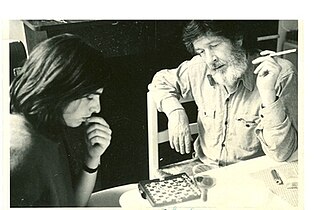
The 15th arrondissement of Paris is one of the 20 arrondissements of the capital city of France. In spoken French, it is referred to as le quinzième.

François Dalle, born on 18 March 1918 in Hesdin and died on 9 August 2005 in Geneva, Switzerland, was a French company director and business executive. He transformed L’Oréal from an SME, founded in 1909 by Eugène Schueller, into the world's leading cosmetics and beauty products company.
Christian Philippe Polak is a French businessman and author who has published several books on 19th-century Franco-Japanese relations; one Le Monde book review called him "the best specialist on this question".
Japanese people in France are French residents and citizens of Japanese ancestry, including both those who have settled in France permanently and those born in the country, along with a significant community of short-term expatriates who spend at most a few years in the country before moving on.
Emmanuel Guillaud is a French artist.

The Institut Français is a French public industrial and commercial organization (EPIC). Started in 1907 by the Ministry of Foreign Affairs for promoting French, francophone as well as local cultures around the world, in 2011 it replaced the CulturesFrance project as the umbrella for all French cultural outreach projects, with an expanded scope of work and increased resources.
Inabata & Co., Ltd. is a specialized trading company and part of the Sumitomo Chemical group. The company's main lines of business include electronic components, housing equipment, chemicals, and plastics.

Inabata Katsutaro was a Japanese industrialist and film pioneer.

The Paris Metropolitan Area includes a Japanese community. In 2013 the official number of Japanese residents in Paris was 16,277.

The Lycée Français International de Tokyo is a French international school in Tokyo with over 1550 students representing more than 65 nationalities. The school consists of a kindergarten, an elementary school, a middle school and a high school.

Nicolas Bernard Fiévé is a French historian of Japanese Architecture; he was born in Paris in 1959 and is the son of the cinema decorator, Bernard Fiévé. In 1993, he became a member of the Centre National de la Recherche Scientifique (CNRS) and in 1996 he joined the Collège de France’s Japanese Civilization research team. In 2007, he was elected Professor at the Historical and Philological Sciences Department at the École Pratique des Hautes Études (EPHE), where he teaches the history of pre-modern Japanese urbanism, architecture and gardens. He is a member of the Accademia Ambrosiana, Milan. Nicolas Fiévé is currently Director of the École française d'Extrême-Orient (EFEO), or French School of Asian Studies.

Lycée Français International de Kyoto or LFIK is a private French international school founded and managed by a parents school board (APEK) accredited by the Agency for French Education Abroad (AEFE).
Francine Hérail is a French historian specializing in Japan. Former resident at the Maison franco-japonaise in Tokyo, she was professor at the Institut national des langues et civilisations orientales until 1981, then director of studies at the École pratique des hautes études until 1998.
Céline Minard is a French writer.
Hugues Randolph Gall is a French opera manager, former head of the Grand Théâtre de Genève and the Paris Opera.

The Cité internationale des arts is an artist-in-residence building complex which accommodates artists of all specialities and nationalities in Paris. It comprises two sites, one located in the Marais and the other in Montmartre. Approximately 1200 artists, choreographers, musicians, writers and designers from around the world live and work in the Cité internationale des arts every year. Residencies are generally a year long.

Claire Julie Liliane Wyart is a French neuroscientist and biophysicist, studying the circuits underlying the control of locomotion. She is a chevalier of the Ordre national du Mérite.

Véronique Joumard is a French artist.

The Fondation pour l'audition is a French scientific foundation for research about hearing impairment. The foundation is located in the 12th arrondissement of Paris.

Marc Dachy was a French art historian whose speciality was Dadaism and Surrealism, an art curator, a translator, lecturer and publisher. The Prix des Créateurs was awarded to Dachy in 1978 by Eugène Ionesco.














